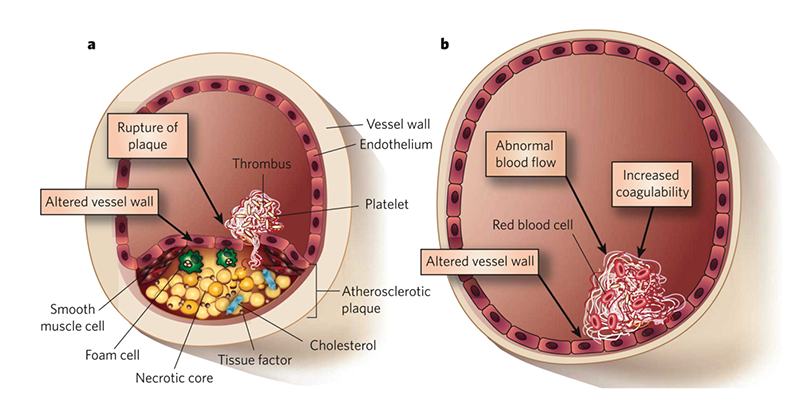| Drug Name | Compoud-006 and compound-011 |
| Description |
The compounds targeting non-muscular myosin heavy chain IIA (NMMHC IIA) were screened out through in vitro experiments (compounds binding rate to NMMHC IIA, cytotoxicity, and the protective effect for cellular oxygen–glucose deprivation/reoxygenation injury). Concluded from thrombosis animal models, compound-006 was effective at reducing arterial thrombosis and compound-011 could significantly inhibit the deep vein thrombosis. |
| Target | NMMHC IIA |
| Drug Modality | Small molecule |
| Indication | Thrombosis |
| Product Category | Inhibitors |
| Mechanism of Action | Inhibiting NMMHC IIA to impede thrombosis |
| Status | Preclinical |
| Patent | Granted |
Protheragen Inc. is actively seeking partnership for compoud-006 and compound-011. Potential collaboration can be strategic alliance, licensing, or marketing agreement.
We look forward to hearing from you.
| Introduction | NMMHC-IIA is a protein encoded by the MYH9 gene, which contains an IQ domain and a myosin head-like domain. NMMHC-IIA is expressed in most cells and tissues where it is involved in several important functions, including cytokinesis, cell motility, and maintenance of cell shape. |
| Approved Name | Myosin heavy chain 9 |
| Official Symbol | MYH9 |
| Gene Type | Protein coding |
| Synonyms | MHA; FTNS; EPSTS; BDPLT6; DFNA17; MATINS; NMMHCA; NMHC-II-A; NMMHC-IIA |
| Ensembl | ENSG00000100345 |
| Gene ID | 4627 |
| mRNA Refseq | NM_002473 |
| Protein Refseq | NP_002464 |
| OMIM | 160775 |
| UniProt ID | P35579 |
| Chromosome Location | 22q12.3 |
| Gene Function | Mutations in MYH9 cause a Mendelian autosomal-dominant disorder known as MYH9-related disease (MYH9-RD). All affected individuals present congenital hematological alterations consisting in thrombocytopenia, platelet macrocytosis, and inclusions of the MYH9 protein in the cytoplasm of granulocytes. Most patients develop one or more non-congenital manifestations, including sensorineural deafness, kidney damage, presenile cataracts, and/or elevation of liver enzymes. |
| Pathway | Akt/GSK3β-NF-κB signaling pathways; caspase-3/ROCK1/MLC pathway |
| Major Conditions | Non-syndromic sensorineural deafness autosomal dominant type 17; epstein syndrome; alport syndrome; sebastian syndrome; fechtner syndrome; macrothrombocytopenia. |
Compound-006 and compound-011 are two small molecule lead compounds targeting NMMHC IIA with high affinity and non-cytotoxicity.
Thrombosis is the formation of a blood clot inside a blood vessel, obstructing the flow of blood through the circulatory system. Venous thrombosis leads to congestion of the affected part of the body, while arterial thrombosis affects the blood supply and leads to damage of the tissue supplied by that artery, such as ischemia and necrosis. A piece of either an arterial or a venous thrombus can break off as an embolus which can travel through the circulation and lodge somewhere else as an embolism.
Thromboembolic conditions have been estimated to account for 1 in 4 deaths worldwide in 2010 and taken together, thrombosis, as the common underlying mechanism of myocardial infarction, ischemic stroke, and venous thromboembolism, is the leading global cause of mortality.
The treatment for thrombosis depends on whether it is in a vein or an artery, the impact on the person, and the risk of complications from treatment. Commonly used medications include anticoagulants, thrombolytic agents, and antiplatelet agents.
NMMHC IIA has important roles in cytokinesis and cell plasticity and is involved significantly in thrombosis regulation. Its deficiency leads to platelet aggregation and thrombosis formation. Previous studies have reported that the inhibition of NMMHCIIA activity could reduce thrombosis development and inflammatory reaction by preventing tissue factor expression and activity. Compound-006 and compound-011, both are NMMHCIIA inhibitors, showed inhibitory effects on venous thrombosis and arterial thrombosis, respectively, from in vivo tests.

Figure. Triggers of arterial and venous thrombosis
From Nature. 2008 February 21; 451(7181): 914–918.
Efficacy test on compound-006 and compound-011 in mice thrombosis models have been completed after the two compounds were screened out.
